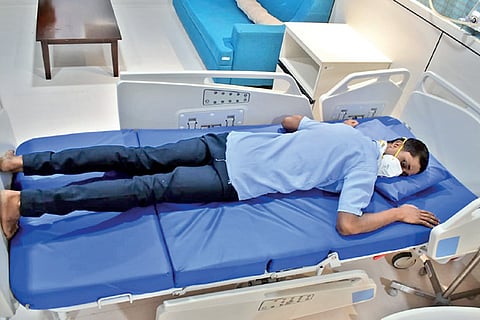

Chennai
As the infection intensifies, many patients with hypoxia become more critical even with oxygen supplementation. But awake proning has proved to be effective. Awake proning is having patients lie on their stomach or on the side. This method has been remarkably effective in boosting the blood oxygen saturation levels in COVID-19 patients who have hypoxia.
Dr Ebenezer, senior consultant and ICU incharge at Apollo Hospitals, said, “When patients lie on their back, the fluid in the lungs in Acute Respiratory Distress Syndrome accumulates at the bottom of the lungs. The heart and other abdominal contents further compress the lung region leading to non-uniform ventilation. Through proning, patients' body is parallel to the ground, thus giving more room for the lungs without any compression. Awake proning eliminates the need for intubation and ventilatory support in some patients”.
A 72-year-old man with underlying COPD was admitted with a poor lung condition and severe hypoxia. He managed with non-invasive ventilator using proning and routine supportive treatment. After further treatment and medical support, he was discharged after forty days.
The doctor added that some patients in critical condition become progressively hypoxic and breathless requiring some form of support and assistance for which oxygen is provided through a non-invasive ventilator called High Flow Nasal Cannula.
A 55-year old man with several comorbidities, including diabetes, hypertension and cardiac conditions, tested positive for COVID-19 and developed acute respiratory distress syndrome. The patient was hypoxic and was stabilised over a period of one week using awake proning at a private hospital in Alwarpet.
Similarly, a 40-year-old diabetic patient who was admitted with severe hypoxemia was successfully treated through awake proning and intubation was avoided. He was treated with required drugs and adhered to the proning protocol and recovered successfully.
However, patients with belly fat and obesity have difficulty in lying down on their stomach. "Many refuse to follow proning protocol or find it difficult to adhere to it. We use pillows on their back and under the armpits to make them comfortable on their stomach and it brings out significant improvement in the patient by helping with uniform oxygenation ensuring complete ventilation across all the organs," said Dr Vijayalakshmi B, senior consultant, infectious diseases, Kauvery Hospital, Chennai.
Doctors follow a protocol of making them sit in a 60-degree angle for two hours, lie on each side for two hours and then their face towards the bed for two hours as a cycle for 12-18 hours, depending on which part of the lung is affected.
In any patient requiring more than 4 litres of oxygen, awake proning protocol is employed. This simple non-invasive technique can eliminate the need for ventilation in some COVID-19 patients, she added.
Visit news.dtnext.in to explore our interactive epaper!
Download the DT Next app for more exciting features!
Click here for iOS
Click here for Android